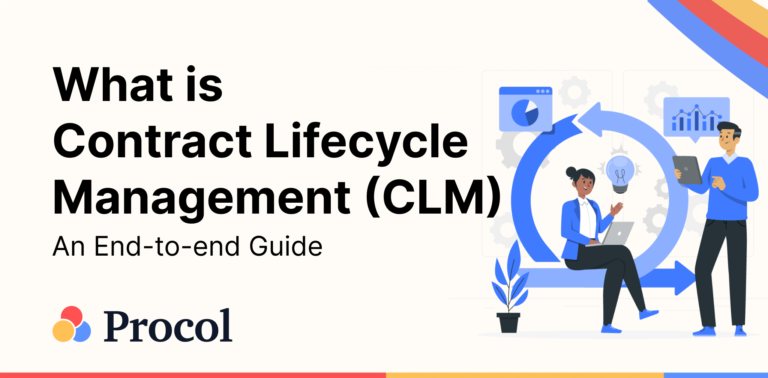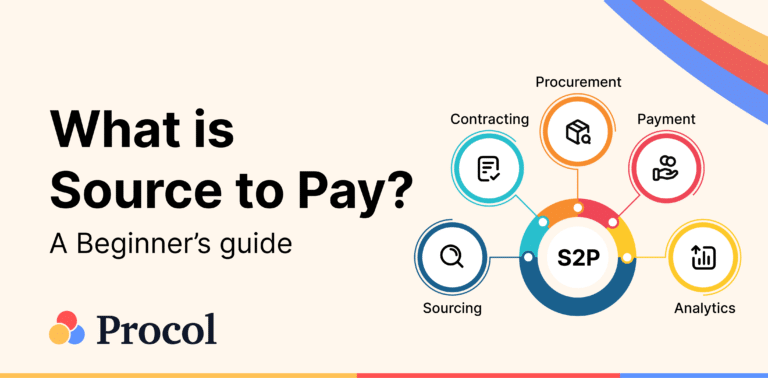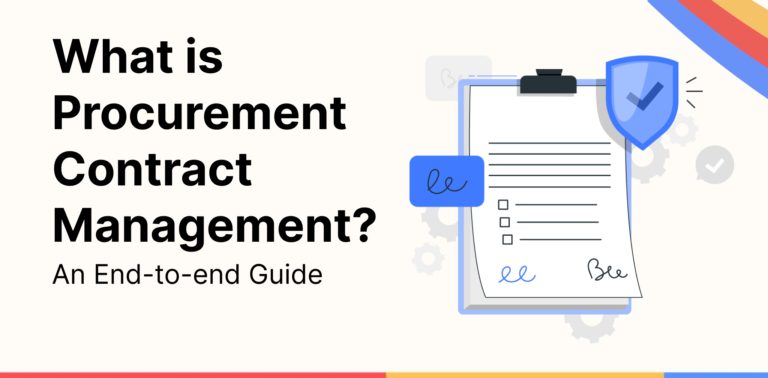Procol • February 19, 2025
Ultimate Guide to What is Contract Lifecycle Management (CLM)

Introduction
In today’s quick-moving business world, companies must work smart and keep things simple to stay on top. That’s where contract lifecycle management (CLM) comes in and changes the game. CLM means taking care of a contract from start to finish – from initiation through award, compliance, and renewal. A sound CLM system can help businesses save time and money, avoid risks, and improve operational transparency. This isn’t just about looking after contracts – it’s about making these agreements work better and last longer to help the business succeed.
This article will explore CLM contract lifecycle management and its potential business benefits, including improved efficiency and growth.
What is Contract Lifecycle Management?
Contract Lifecycle Management (CLM) is a crucial process for managing contracts from start to finish using specialized software. It boosts savings efficiency and reduces risks by ensuring legal compliance. It tracks every aspect of a contract’s performance and compliance. The process includes planning, creation, negotiation, approval, execution, operation, and renewal or expiry. With AI integration, CLM focuses more on post-execution stages for better management. During creation, the software uses templates based on specific criteria. Negotiation aims for clear, enforceable agreements.
The approval process uses rule-based workflows for sequential and parallel approvals. Thus, execution has become more flexible, allowing remote approvals via digital devices. Effective CLM streamlines processes, saving organizations time and money, making it crucial in today’s business world.
Why is Contract Lifecycle Management Important?
Contract Lifecycle Management (CLM) plays a key role in today’s business world, where legal and financial risks are high. Contract life cycle management matters because it offers a clear strategy for handling contracts, which form the backbone of business activities. This system helps companies to manage their contracts well from start to finish. As a result, it keeps the business running, reduces risks, and enhances compliance with relevant regulations.
Contract Lifecycle Management (CLM) plays a key role in today’s businesses for several important reasons:
- Contract lifecycle management helps manage risks by spotting potential problems in contract terms before they cause issues. This early warning system helps avoid legal disputes and money losses.
- Contract lifecycle management impacts productivity by automating contract processes. This reduces manual work and mistakes and speeds up the entire contract process.
- Contract lifecycle management influences business relationships by ensuring everyone understands their duties and responsibilities. This builds trust and transparency with partners.
- Contract life cycle management provides valuable insights into contract performance. This allows businesses to make intelligent decisions and improve future deals.
10 Stages of the Contract Lifecycle Management (CLM) Process
The CLM Contract Lifecycle Management process helps businesses manage contracts from beginning to end. It has ten stages, each playing a pivotal role in managing contracts throughout their lives.
1. Requirement Identification: Companies spot the need for a contract when a new business needs to be created or a chance comes up.
2. Authoring: Write contracts using standard templates and clauses to keep things the same and follow legal rules.
3. Review: Check the written contract to make sure all terms are correct and meet the necessary compliance requirements.
4. Approval: Before execution, contracts must be approved by all parties involved. This stage often requires multiple levels of approval within an organization.
5. Execution: Contracts are formally executed by all parties involved, often with digital signature technologies, to streamline the contract lifecycle management process.
6. Obligation Management: Once executed, the contract enters the obligation management phase, during which the parties ensure that all contractual commitments are being met.
7. Amendment and Revisions: Amendments manage any changes or updates to the contracts. This stage ensures that the contract remains relevant and up-to-date with changing business circumstances.
8. Auditing and Reporting: Regular audits ensure compliance with the contract terms and assess both parties’ performances.
9. Renewal: As contracts approach expiry, decisions are made regarding their renewal based on the agreement’s performance and continued relevance.
10. Disposition and Termination: Finally, contracts that are not renewed are terminated, and all necessary procedures are followed to close the contract properly.
History of CLM
Contract Lifecycle Management (CLM) has developed significantly from traditional paper-based contracts to modern CLM contract management solutions. Earlier, businesses depended on manual processes, which made contract tracking and compliance challenging. With the rise of digital transformation, contract lifecycle management processes have become more automated, improving efficiency and reducing risks. Today, CLM or contract lifecycle management systems merge artificial intelligence (AI), analytics, and automation to ease the contract life cycle management process, offering better insight and control over agreements.
Key metrics for contract lifecycle management
Tracking the right metrics in contract lifecycle management is important for changing contract performance and minimizing risks. Some key performance indicators (KPIs) include:
- Contract approval time: Measures the efficiency of the contract lifecycle management process by tracking how long it takes to approve agreements.
- Contract renewal rate: Indicates how effectively contracts are managed and renewed before expiration.
- Compliance rate: Ensures adherence to legal and regulatory requirements within CLM contract management processes.
- Contract value leakage: Tracks lost revenue due to missed milestones, pricing errors, or non-compliance.
- Cycle time: Evaluate how quickly contracts move through different stages of the contract life cycle management process.
What are the best CLM practices, and how to implement them?
Implementing best practices in CLM (contract lifecycle management) helps businesses maximize usefulness and reduce contract-related risks. Here’s how:
- Centralize contracts in a CLM system: Use a contract lifecycle management platform to store and organize contracts in a safe and searchable database.
- Automate contract workflows: Smoothens approvals, negotiations, and renewals using an automated contract lifecycle management process to remove problems.
- Set clear contracting policies: Simple contract templates and clauses to make sure consistency over agreements.
- Oversee compliance & performance: Use CLM contract management tools to track main contract values and ensure duties are met and risks are reduced.
- Merge CLM with business systems: Connect contract lifecycle management software with CRM, ERP, and procurement platforms for smooth contract execution.
By utilizing these best practices, businesses can improve efficiency, reduce errors, and take greater control over their contract lifecycle management processes.
Benefits of Contract Lifecycle Management
Using CLM Contract Lifecycle Management tools in a company has many benefits that boost the speed and quality of contract handling. These systems make all parts of CLM contract management run smoother, from writing and negotiation to following rules and renewal. This leads to significant improvements in several key areas.
- Contract life cycle management tools make contract management easier by doing routine jobs. This cuts down on time and mistakes while ensuring compliance. They offer real-time tracking, warn about important deadlines, and give detailed reports on how well things are going. This gives people a better view and more control over the whole process.
- These systems improve risk management through standardized processes and analysis tools, helping organizations consistently apply terms and manage legal and financial exposure. They also foster collaboration with shared workspaces and communication features, speeding up negotiations and strengthening business relationships.
- CLM contract lifecycle management systems reduce the need for extensive legal consultations and administrative support, which saves money. Companies can focus on big plans instead of everyday jobs by making many parts of the contract process run independently.
Key features of contract lifecycle management
CLM contract lifecycle management features make managing different parts of the contract process, from start to finish or cancellation, more accessible.
Automated Workflow:
A prominent feature of Contract lifecycle management systems is their automation of workflows. This impacts tasks like drafting contracts, getting approvals, and execution processes. Automation helps reduce the time and work needed to handle contracts and reduces mistakes people might make.
Central Contract Storage:
Contract lifecycle management systems offer a centralized location to keep all contract-related documents. This storage makes it simple for users to find, obtain, and handle contracts during their lifecycle. It also ensures that all contract information stays safe and that only people with permission can see it.
Compliance Management:
Sticking to legal standards and company policies is critical when managing contracts. Contract lifecycle management systems have tools to watch and enforce these rules throughout a contract’s life. This feature helps lower risks of breaking the rules, like legal fines or money losses.
Risk Management Tools:
These systems include tools to assess risk that determine and spot possible risks in contract terms and conditions. They give insights that help you make smart choices and take steps ahead of time to lessen the risks you’ve found.
Performance Analytics:
Contract lifecycle management solutions offer analysis tools and reports that give deep insights into contract performance. These tools help companies monitor key performance indicators (KPIs) and see how well their contract management methods work. The insights gained from the performance can be used to improve future contracts and boost the whole operation’s performance.
E-signature Features:
As remote work grows, e-signature features play a crucial role in today’s CLM systems. They let people sign contracts online, speeding up the final steps and offering a safe and legal way to close deals.
Ability to Connect:
Good Contract lifecycle management systems are built to work with other business tools, like CRM (Customer Relationship Management), ERP (Enterprise Resource Planning), and external legal databases. This connection ensures CLM contract management processes align with other parts of the business, which helps the whole company run better.
Why Procol is the best?
Procol’s Clm Contract Lifecycle Management solution streamlines clm contract management and boosts efficiency and compliance. Their system handles the entire contract lifecycle, ensuring alignment with organizational goals.
Procol’s Contract life cycle management provides a disciplined approach to managing agreements, minimizing risks, and improving contract performance. The comprehensive software automates tasks and centralizes contracts online, saving time and reducing manual management risks. Advanced search and notification features enhance user experience.
Custom reporting tools generate insights from contract data, aiding strategic decision-making. The system helps identify contracts due for renewal and understand clause implications.
Procol also focuses on risk management and compliance, ensuring contracts meet current regulations. This reduces legal issues and improves operational integrity.
Companies using Procol’s CLM solution can boost their productivity and follow the rules more effectively, making it a top pick in the market.
Contract lifecycle management (CLM): Buy-side vs. sell-side
In contract life cycle management (CLM), it’s essential to distinguish between buy-side and sell-side agreements. This difference plays a crucial role in handling procurement contracts effectively.
| Buy-side | Sell-side |
| Buy-side contracts involve purchasing goods or services, typically managed by procurement departments. | Sell-side contracts pertain to selling goods or services, primarily handled by sales teams. |
| Buy-side contracts may feature stringent termination clauses for non-performance, | Sell-side agreements might focus on penalties for late payments. |
| Activities include strategy management, vendor selection, and compliance with purchase agreements. | Sell-side contracts are vital for revenue generation, thus requiring meticulous management to optimize turnaround times and maintain client relationships. |
| These contracts focus on acquiring the best possible terms for the buyer, emphasizing cost, quality, and delivery conditions. | These contracts aim to maximize revenue and ensure the seller’s interests, focusing on terms like payment conditions and warranties. |
Ultimately, whether managing buy-side or sell-side contracts, the adoption of a comprehensive contract lifecycle management solution facilitates a more cohesive, efficient, and compliant process, aligning with procurement and sales strategies to support business objectives.
Conclusion
As we examine the complex details of CLM Contract Lifecycle Management, we can see that using a CLM system isn’t just a choice but a must for companies that want to boost their productivity and lower risks. Furthermore, examining different aspects, from how vital contract life cycle management is in today’s business world to a deep look at what the software can do, shows the strategic worth that an entire CLM system brings to a company. By helping create a more organized way to handle procurement contracts from start to finish, businesses can better use agreements as practical tools to manage risks, work more, and build relationships.
Frequently asked questions
What is a contract lifecycle management system?
A contract lifecycle management (CLM) system is a digital solution that helps organizations manage contracts from creation to carrying out, renewal, and expiration. It automates the contract lifecycle management process to ensure efficiency, compliance, and risk measurement. A CLM contract lifecycle management system acts as a central platform for storing, tracking, and analyzing contracts. Businesses use it to smoothen approvals, manage negotiations, and make sure of regulatory compliance. By merging with other business tools, CLM contract management improves insights and controls the entire contract life cycle management process.
How does contract lifecycle management work?
The contract lifecycle management process follows a structured approach to handle contracts from creation to accomplish tracking and renewal or removal. First, contracts are created using standard templates, which ensure consistency and compliance. During the negotiation and approval stage, a CLM contract lifecycle management system automates the working process to speed up the process. Once approved, electronic signatures facilitate quick completion, making contracts legally binding. After completion,, contracts are stored in a centralized storage area for easy access and tracking. Throughout the contract, CLM contract management tools monitor compliance, deadlines, and financial terms, sending automated alerts for renewals or necessary actions. By merging contract life cycle management with business systems, organizations can smoothen operations, lessen risks, and enhance contract performance.
Why is contract lifecycle management important?
Contract lifecycle management is important for businesses as it ensures efficiency, compliance, and risk reduction throughout the contract process. Without a proper contract lifecycle management process, organizations may struggle with contract mismanagement, missed deadlines, and financial risks. A well-implemented CLM contract lifecycle management system automates contract workflows, making approvals easier and reducing human errors. It also helps businesses stay compliant with legal and regulatory requirements by tracking main contract terms and duties. Also, CLM contract management improves mergers between teams, making sure that contracts are created, executed, and monitored effectively. By improving contract life cycle management, companies can reduce risks, control costs, and increase contract value.
Explore more from Procol
Discover expert tips, how-to guides, industry insights, and the latest procurement trends.

What is Source-to-pay in 2025? An Ultimate Guide
Source to pay is the process of sourcing vendors to procure...

End-to-End Guide to What is Procurement Contract Management?
Wondering what is procurement contract management, then this end-to-end guide explains...

Best Contract Management Software in 2025: A Buyer’s Guide
Contract management software is crucial for modern business. This article explores...









